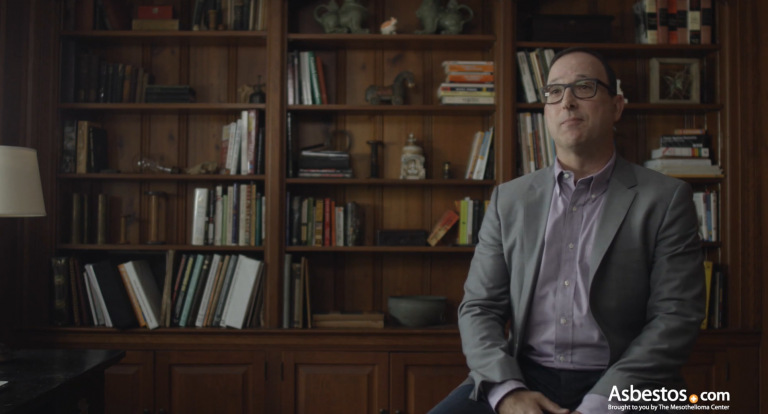Navy veteran Jerry Cochran was given the job of scraping and grinding nonskid paint off of the U.S.S. Independence in Portsmouth, Virginia. “We didn’t know at that time that it was silica [with] aluminum, nickel, asbestos and other minerals in the dust that was being kicked up,” he said. “Basically, the ship was a killing field.”
U.S. Military Occupations and Asbestos Exposure
U.S. military veterans, including those in the Navy, Air Force, Army, Marines and Coast Guard, were exposed to asbestos while on duty. Veterans who served from the 1930s to the mid-1970s are at high risk of asbestos-related cancers and respiratory diseases.
Why Asbestos Was Commonly Used in the Military
The U.S. military used asbestos for its fire-resistant and insulating traits. The period of greatest use was from the 1930s through the 1980s. All military branches, from the Army to the Coast Guard, used it on ships, vehicles, aircraft and bases.
Widespread use of asbestos in military jobs put many personnel at risk of repeated exposure. Records show the military knew of asbestos health risks by the 1930s. But the Navy continued to rely on the material to protect its ships.
- About 33% of all mesothelioma patients are veterans, a 2022 Defense Department report shows.
- U.S. military started using asbestos in the 1930s and continued using it for nearly 50 years.
- Navy servicemembers had the highest exposure to asbestos on ships and shipyards.
The military began to limit asbestos use after 1975. But legacy asbestos in old machinery, bases and other products still poses a threat to servicemembers and their families. Soldiers can also encounter asbestos in countries where it’s not banned.
Veterans from all branches of the U.S. military now have an elevated risk of developing mesothelioma and other asbestos-related diseases.
Military Branches With High Risk of Asbestos Exposure
Navy veterans are most at risk of exposure because of the widespread use of asbestos on Navy ships. In general, most veterans who served between the 1930s and 1980s are at risk of asbestos exposure.
A 2022 Defense Technical Information Center report found that “military veterans account for one-third of all [mesothelioma] patients.”
There’s a direct link between asbestos-related risks and certain Military Occupational Specialties or military fields. But asbestos exposure by MOS varies. Some jobs have particularly high risks. Many servicemembers encountered asbestos living in military housing. Others had secondary exposure from contact with a servicemember with a high-risk job. Their exposure led to mesothelioma, asbestosis and other asbestos-related diseases.
Navy Veterans
Navy veterans had the highest risk of asbestos exposure. It was because of the extensive use of the fibrous mineral in shipbuilding, engine rooms and boiler rooms. Boatswain and machinist mates, shipbuilders, boiler technicians, machinists, welders, pipefitters, electricians, and fire control technicians were most at risk of exposure.
The Navy’s use of asbestos peaked during World War II and lasted until the 1970s. Navy ships, in particular, used asbestos in hundreds of ways. Some uses were to insulate pipes and line ventilation ducts.
Navy veteran and mesothelioma survivor Bob Niemiec entered the Navy in 1965. His first assignment out of boot camp was to scrape paint off the landing ship U.S.S. Hermitage. The paint he was scraping contained asbestos.

Learn how to access benefits available to veterans affected by an asbestos-related illness.
Get Help NowArmy Veterans
Army vehicle mechanics, construction engineers, and electricians faced a higher risk of asbestos exposure on the job. The U.S. Army began using asbestos in the 1930s for bases, barracks, vehicles, planes, weapons and other gear.
Mesothelioma survivor and Army veteran Daniel McCarthy spent 3 years with the 4th Armored Division in Germany. He believes his years in the Army exposed him to asbestos.
Air Force Veterans
Air Force personnel spent most of their deployment in and around military aircraft that once contained asbestos. Fighter, trainer, and utility planes all used asbestos products in the engines, wiring, turbines, brake pads, insulation and heat shields.
Pilots and people who worked on planes, such as maintenance specialists, welders and aircraft mechanics, may have had higher levels of asbestos exposure.
Marine Corps Veterans
U.S. Marine Corps veterans often faced asbestos exposure. This was because their work as combat engineers, mechanics, and other shipboard roles on Navy ships. Marine veterans often had the same high risk of asbestos exposure by MOS as most Navy personnel. Exposure was also high among Marine Corps construction and demolition workers on military bases.
Specific Military Occupations at Risk for Asbestos Exposure
Navy personnel had the highest link between military jobs and asbestos exposure. But no servicemembers were safe from asbestos in construction and vehicle parts.
Shipyard Workers
Shipyard workers had high levels of asbestos exposure while building, repairing and dismantling Navy ships. Many of these ships were built before 1980s asbestos regulations. The Navy used asbestos in engine and boiler rooms to strengthen and fireproof them.
Shipyard buildings also had high amounts of asbestos-containing construction materials. Many shipyard workers also used products that put them in daily contact with asbestos.
Boiler Technicians and Pipefitters
Boiler technicians operate and repair the steam boilers that power older Navy ships. Asbestos was very common in boiler and engine rooms because it insulated them and made them resistance to heat and fire.
Pipefitters built and maintained the ship’s pipe systems that supplied water and steam to the boilers. These pipes were a main source of asbestos exposure in the military. Pipefitters worked with loose asbestos and asbestos-containing gaskets, seals and insulation.
Construction Engineers and Seabees
Construction and maintenance jobs often expose workers to asbestos in building materials and in engine and machinery parts. Military construction workers often worked with asbestos in roofing, insulation and cement products. They encountered it daily.
Members of the U.S. Navy Construction Battalion, known as Seabees, perform various construction projects. They clear land, build bases and pave roads and runways. Seabees are skilled in welding, plumbing, carpentry and electrical work. These duties frequently increased Seabees’ risk of asbestos exposure by MOS because it was used in everything from gaskets to insulation to paint.
Aircraft Mechanics
Aircraft mechanics repair and maintain military aircraft engines. They often experienced asbestos exposure in the military while using contaminated body filler and rebuilding engines. Asbestos components in aircraft engines include gaskets, seals, insulation, gearboxes, brakes, clutches and wiring.
Vehicle Mechanics
Army and Marine vehicle mechanics routinely came into contact with asbestos while working on military vehicles. Before asbestos regulations banned its use, vehicle mechanics were at high risk. They were exposed to asbestos while removing and installing brake pads, clutches, wheel bearings and gaskets. Mechanics also regularly handled asbestos-insulated engine parts, gearboxes, wiring and other components.
What Should Veterans Do if They Were Exposed to Asbestos on the Job?
Veterans who suspect asbestos exposure in the military should speak to a medical provider. It is a good idea to get a medical screening for asbestos-related diseases before symptoms develop.
- Discuss prior exposure with a health care provider
- Establish proof of exposure
- File a VA claim (if applicable)
Many veterans with asbestos-related illnesses can file a VA claim for disability compensation. Mesothelioma VA claims need proof asbestos exposure during military service caused the disease. You will need detailed records, such as service records, Form DD214, and medical records from your service.
A VA-accredited representative can help patients gather the appropriate evidence to substantiate the claim and write the exposure summary. Getting help can expedite the claims process.
Military Occupations and Asbestos Exposure: Preventing Future Risks
Understanding how asbestos exposure occurred in military occupations can help prevent future risks. Asbestos use in the military has declined a lot since the 1970s. But the long latency period means veterans who served in virtually every occupational specialty are still developing symptoms of asbestos-related diseases. Exposure to legacy asbestos on ships and in older facilities can still happen today.
Current regulations aim to minimize the link between military jobs and asbestos exposure. Military branches have made comprehensive plans to limit risks associated with asbestos exposure. For example, all Army installations must have an active Army Asbestos Management Program. They must also comply with all federal, state, and local regulations, including those for overseas installations.
- Improved safety protocols, including asbestos management plans
- Safe removal of asbestos from older buildings and ships
- Training on the use of proper PPE for military personnel
Veterans may be able to seek compensation through Veterans Administration disability claims. Veterans cannot sue the U.S. government for asbestos exposure in the military, but they can hold companies that contracted with the military responsible.
These essential occupations kept the ship and crew safe and ready for combat or emergencies, but the work left its toll. Navy veterans account for nearly a third of all malignant mesothelioma cases.
Common Questions About Asbestos Exposure by MOS
- How can veterans know if they were exposed to asbestos in the military?
-
The location and dates of service, military occupations, and health records can all help verify that asbestos exposure happened during a veteran’s time in service. All branches of the military had a strong link between asbestos exposure and military occupations. From the 1930s to 1970s, veterans at some job sites, and those in construction or shipyards, had a high risk of asbestos exposure.
- What symptoms should veterans watch out for after asbestos exposure?
-
Common symptoms like shortness of breath, chronic dry cough, fatigue, nausea, chest pain, back pain or weight loss. Fluid buildup in the lungs (pleural effusion) is one of the most common symptoms. Patients may also experience fever, muscle weakness, difficulty swallowing, swelling of the arms and face or loss of appetite.
- How can veterans exposed to asbestos on the job apply for VA benefits?
-
Honorably discharged veterans can use VA Form 21-526 to apply for VA benefits. The VA provides benefits on a percentage scale based on the veteran’s disability level. Working with VA-accredited Claims Agents can speed up the processing time from an average of eight months to four.
Along with VA Form 21-526, you must provide the VA with an exposure summary, your discharge paperwork, verification of a medical diagnosis and medical records. You can do this in person, by mail or online.
- How does asbestos exposure lead to mesothelioma?
-
When you inhale or swallow asbestos fibers, the body has a very hard time dislodging and removing them. They can lodge in the lining of the lungs, stomach and heart, where they cause tissue irritation and scarring. This scarring can eventually cause cancer of the mesothelium, or malignant mesothelioma. It can take decades for asbestos to cause cancer.




